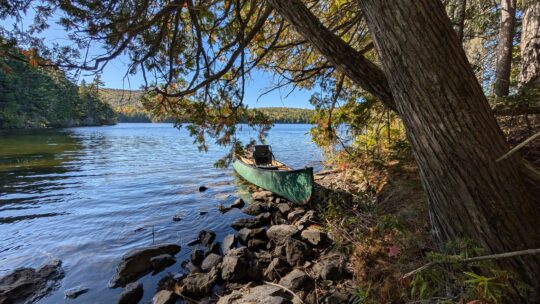
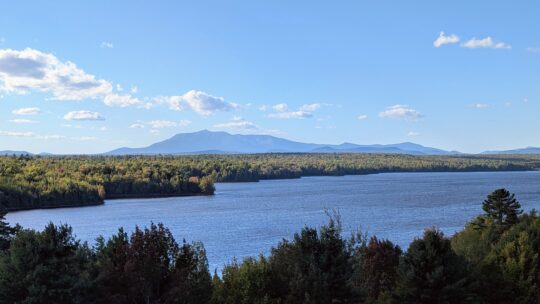
“Do you want to stop for lunch?” TJ asked.
“No thanks,” I replied.
It’s typical that I would not stop for lunch if I am fishing and haven’t caught a fish. I’m not sure if that habit is based out of stubbornness or a calculation that when the fishing is slow I will need every possible minute to maximize my chances to catch something. More than likely I just know I won’t be able to sit still, and whatever I am eating will not taste very good anyway. After thinking about the fact that the guide, TJ, had been paddling the canoe in the wind for several hours while I probed the depths of the pond with my fly, I changed my mind and we headed ashore.
While munching on sandwiches we chatted about our elusive quarry on this remote Maine pond: landlocked Arctic Char. Also known as Blueback Trout, Sunapee Trout, Golden Trout, and White Trout; not even the most commonly used scientific name of Salvelinus alpinus oquassa is agreed upon by all. There is good reason for this: Anders Klemetsen awarded Arctic Char the title of “the most variable vertebrate on Earth” in his book “The Most Variable Vertebrate on Earth.” Even the spelling of its name is varied, as many ichthyologists use the two “r” char spelling, while the single “r” char is more commonly used in most online descriptions. About the only thing that everyone agrees upon is that they are native to Maine and difficult to catch. I wouldn’t have to worry about what to call this fish or how to spell it until I could actually catch one, so we headed back to our canoes.
Thanks to a phone call a few days earlier from my friend Steve Howell to fill in for a friend who had to cancel, I was fishing this beautiful remote Maine pond with the always fishy Steve, new friend Mike Deloia and our guide TJ Hebert of Maineiac outfitter. We were in separate canoes, both of which had been carried all the way in along a gnarly trail. Steve and Mike were alternating between flies on lead core and small lures while trolling. TJ had me fly casting a small streamer on a weighted line. Steve has a bounty of experience trolling for trout and salmon and he applied it well, being the first to hook a char. As Mike reached out with the net, a glowing orange shape emerged from the water and we all gave a whoop. Pictures were taken to document the moment and I went back to casting the six weight.
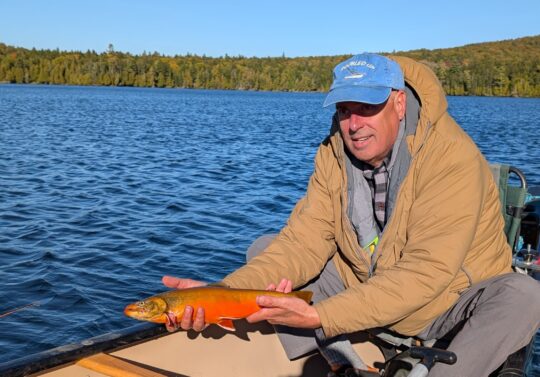
Casting a weighted line is something I am not accustomed to, and the wind and canoe were not doing my efforts any favors. My fly line tangled up on a cast and I had to work all along the the line to clear the stubborn knots. TJ alertly kept us in position as I worked on my bird’s nest of line, and just as I reached the end of the knot the line went tight and I had a fish on! The rod doubled over and the fish dug for the bottom. These fish have a tendency to roll on the line and do some funny things so I was careful in bringing it up towards the boat. I had to give the fish line multiple times. Each large head shake made the rod and my heart thump. A brilliant, almost unnaturally bright red and orange burst of color suddenly appeared and I had caught my first landlocked Artic Char- a male colored up for spawning season. I was in awe.
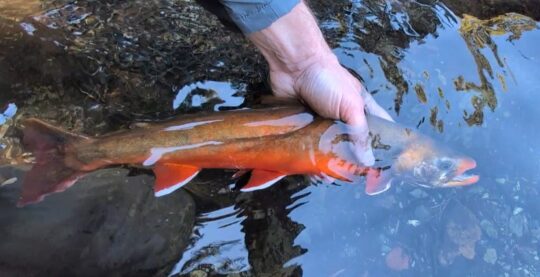
This was a fish of considerable size, which we measured at 18 inches long. Char have very fine scales that give the body a smooth feel similar to skin. The mouth showed an smear of orange lipstick- perhaps from a rendezvous with an amorous female at depth? The electric color of the fins seemed to somehow surpass the brightness of the belly. It didn’t seem that any of the photographs we took did the coloration of these fish justice-the closet comparison I could think of was fluorescent orange spray paint
Mike was the next to hook up, and we were all excited when he landed an arctic char of his own. Since everyone in the group had caught their first char, TJ was excited to relish a celebratory cigar at the campfire that evening. I get the feeling that he rarely misses out on being able to have a cigar.
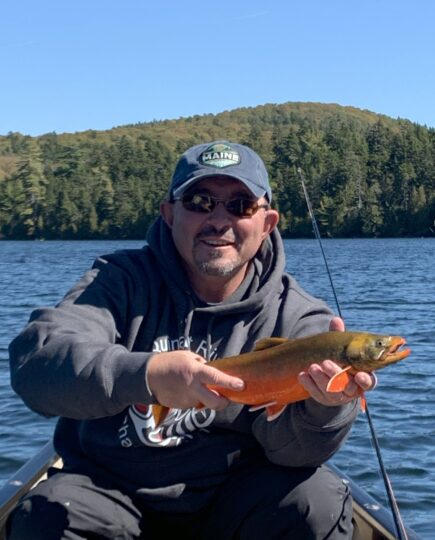
We each ended up with two char the first day, as well as a smattering of brook trout in the 12″ range. As possibly my favorite fish, this was the first time for me where hooking into a brook trout was a little bit of a let down. I suppose that comes with the territory when your target is a rare salmonid found in about a dozen ponds in the Continental united States. Although there are occasionally larger specimens of brook trout, we did not see any on this trip.
Back at the campsite we toasted with bourbons and sat around the campfire trading fish stories. TJ prepared a delicious dinner which was immediately devoured. As the drinks were consumed the stories devolved until my sides hurt from laughing. Mike asked for a pause in the commentary so he could breathe without laughing. I’m not sure I can recall a single joke told at fish camp that I could repeat here. We layered on the sleeping bags and tucked in to the tent to try to stay warm as the temperature headed down below freezing.
Awakening rather stiffly, we added layers to face the cold and ate a hearty breakfast. Day two of fishing was similar in terms of fishing success, with mostly slow periods interspersed by small bite windows where we would feel a bump or land two fish amongst us. We each managed two char (with captain Steve bring four to the net) on the second day. We got most of our takes about 20-25′ in depth where the water was much cooler than at the surface. The colors on the female char were not as garish as the males, with colors ranging from gold and blue hues melting down towards some orange and red on the belly.
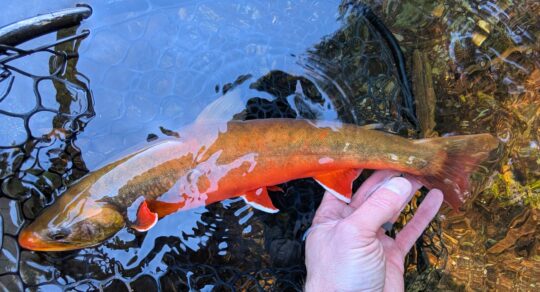
Although the colors varied from fish to fish, we found these Arctic Char to be strong fighting fish. The group concluded that for this particular pond Arctic Char would put up a stronger fight when compared to a Brook Trout (actually a fellow char) of the same length. When hooked, they would usually invert and dog towards the bottom, pulling relentlessly. Once brought to the surface, the char seemed to have a knack for shaking the hook right at the boat. The largest we caught was about 18″, with Mike catching the longest specimen. His fish exhibited GAC, or “growth after catch” whereby the length of the fish increases each time the story of landing it is told.
I feel it is necessary to acknowledge the protection and management of this rare native species by the Maine Department of Inland Fisheries and Wildlife. Following their Arctic Char management plan, Maine has committed to protecting this distinct subspecies of Arctic Char. Now absent from other native ponds in New Hampshire and Vermont where they were formerly found, each Maine pond where these fish still occur represents a distinct gene pool. MDIFW focuses on management that warrants protection for each individual population. They have also undertaken reclamation projects to preserve populations of Arctic Char after introductions of Rainbow Smelt or Landlocked Salmon have threatened char populations. As I hope these photos show, these populations are definitely worth preserving.
If you are up for adventure and enjoy pursuing native fish in their natural habitat, I suggest you reach out to TJ Hebert of Maineiac Outfitter. TJ’s knowledge, persistence, and experience were the reasons that this trip was a success.
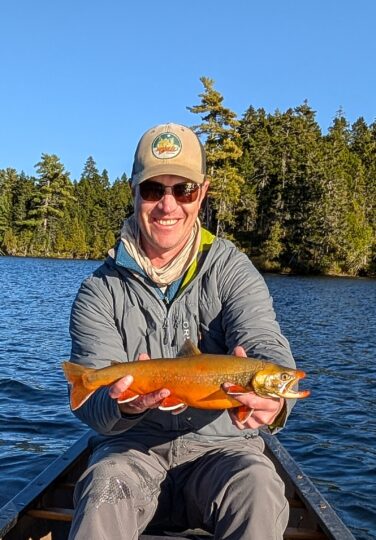
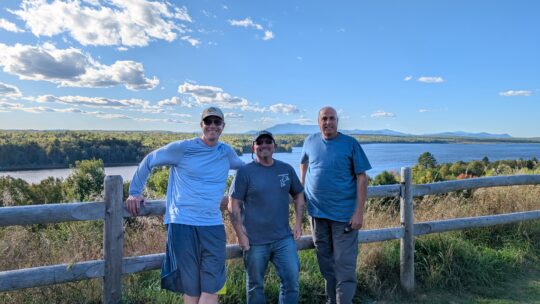
Discover more from BlogFlyFish.com
Subscribe to get the latest posts sent to your email.

Fantastic adventure, well told — stuff of legend!
Right on Clint! Cheers.